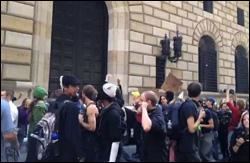Courtesy of Pam Martens.
The Federal Reserve will celebrate its 100th anniversary on December 23 of this year. But the Federal Reserve did not function as the nation’s central bank until 1922 when it fumbled and stumbled its way into an awareness of the power of a centralized mechanism for buying and selling U.S. government securities as a means of carrying out monetary policy. Thanks to a trove of historic documents recently released by the St. Louis Fed, we are now able to see how the New York Fed, a bastion of Wall Street interests, maneuvered itself into control of that process.
Incredibly, from its legislative creation in 1913 until 1922, the Federal Reserve had 12 separate “central” banks carrying out monetary policy for their region of the country. Each of the 12 regional Federal Reserve banks was allowed to buy and sell government securities and trade acceptances. The tide turned in 1922 when the regional banks, to compensate for a dramatic loss of earnings from loans, began independently buying up hundreds of millions of dollars of U.S. government securities to shore up their earnings in order to pay the mandated 6 percent annual dividend to their member bank shareholders, making a dramatic and noticeable impact on the money markets in New York.
At a conference of the regional Federal Reserve banks on May 6, 1922, the powerful head of the New York Fed, Benjamin Strong Jr., became the first Chairman of the body that is now known as the Federal Open Market Committee. At the time, it was given the name: Committee on Centralized Execution of Purchases and Sales of Government Securities by Federal Reserve Banks. Strong, through force of personality, began to channel all trading of U.S. government securities through the New York Fed.
Denoting where power rested in the Federal Reserve System of 1922, on May 25, 1922, George Harrison, second in command at the New York Fed, wrote to the heads of the other regional Federal Reserve banks, advising them that: “Governor Strong has today suggested that Mr. Matteson of this bank act as the operating secretary of the [open market] committee, and has advised each of the banks by telegram that if there is no objection to that appointment the committee will commence functioning tomorrow.” The letter further notes that “This whole program was reported to the Federal Reserve Board at the luncheon…”
A matter as critical as the first functioning of central bank open market operations is being “reported” to the Federal Reserve Board over lunch, much as someone might whisper gossip between “pass the butter” and “where’s the salt.”
…




